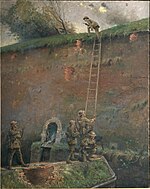Belfry of Namur
Bell towers in BelgiumBuildings and structures in Namur (city)Tourist attractions in Namur (province)Towers completed in the 18th centuryWallonia's Major Heritage ... and 1 more
World Heritage Sites in Belgium

The Belfry of Namur (French: Beffroi de Namur), also called the Tour Saint-Jacques ("Saint Jacob's Tower"), is an historical building in Namur, Belgium. The tower, constructed in 1388 as part of the city wall, became a belfry in 1746. It is one of the 56 belfries of Belgium and France classified by UNESCO as a World Heritage Site because of their importance as a representation of civic architecture in Europe and their testimony to the rising and influence of the city.
Excerpt from the Wikipedia article Belfry of Namur (License: CC BY-SA 3.0, Authors, Images).Belfry of Namur
Rue du Beffroi, Namur
Geographical coordinates (GPS) Address External links Nearby Places Show on map
Geographical coordinates (GPS)
| Latitude | Longitude |
|---|---|
| N 50.463888888889 ° | E 4.8669444444444 ° |
Address
Le Beffroi (Tour Saint-Jacques)
Rue du Beffroi 4
5000 Namur (Namur)
Namur, Belgium
Open on Google Maps










